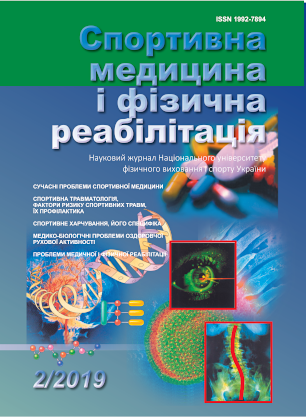Сотрясения мозга в спорте и использование алгоритма SCAT5 для быстрой оценки состояния спортсмена с черепно-мозговой травмой в ходе соревнований
Основний зміст сторінки статті
Анотація
Блок інформації про статтю

Ця робота ліцензується відповідно до Creative Commons Attribution 4.0 International License.
Журнал практикує політику негайного відкритого доступу до опублікованого змісту, підтримуючи принципи вільного поширення наукової інформації та глобального обміну знаннями задля загального суспільного прогресу.
Редакційна колегія дотримується рекомендацій The Committee on Publication Ethics (COPE) з питань этики наукових публікацій.
ОБОВ'ЯЗКОВЕ ПОСИЛАННЯ НА АВТОРІВ ПРИ КОПІЮВАННІ ЧИ ЦИТУВАННІ МАТЕРІАЛУ НАУКОВИХ СТАТЕЙ
Автори, які публікуються у цьому журналі, погоджуються з наступними умовами:
- Автори залишають за собою право на авторство своєї роботи та передають журналу право першої публікації цієї роботи на умовах ліцензії Creative Commons Attribution License, котра дозволяє іншим особам вільно розповсюджувати опубліковану роботу з обов'язковим посиланням на авторів оригінальної роботи та першу публікацію роботи у цьому журналі.
- Автори мають право укладати самостійні додаткові угоди щодо неексклюзивного розповсюдження роботи у тому вигляді, в якому вона була опублікована цим журналом (наприклад, розміщувати роботу в електронному сховищі установи або публікувати у складі монографії), за умови збереження посилання на першу публікацію роботи у цьому журналі.
- Політика журналу дозволяє і заохочує розміщення авторами в мережі Інтернет (наприклад, у сховищах установ або на особистих веб-сайтах) рукопису роботи, як до подання цього рукопису до редакції, так і під час його редакційного опрацювання, оскільки це сприяє виникненню продуктивної наукової дискусії та позитивно позначається на оперативності та динаміці цитування опублікованої роботи (див. The Effect of Open Access).
Посилання
Ianof JN, Freire FR, Calado VTG, Lacerda JR, Coelho F, Veitzman S, Schmidt MT. et al. Sportrelated concussions. Dementia & Neuropsychologia. 2014 Jan-Mar; 8(1):14–19. DOI: 10.1590/S1980-57642014DN81000003
Abrahams S, Fie SM, Patricios J, Posthmus M, September A. Risk factors for sports concussion: An evidencebased systematic review. British Journal of Sports Medicine. 2014;48:91-97 DOI: 10.1136/bjsports-2013-092734
McCrea M. Standardized mental status testing on the sideline after sport-related concussion. Journal of Athletic Trai ning. 2001 Jul-Sep;36(3):274-9.
McCrory P. Preparticipation assessment for head injury. Clinical Journal of Sport Medicine. 2004;14(3):139-44. DOI: 10.1097/00042752-200405000-00006
Kutner KC, Erlanger DM, Tsai J, Jordan B, Relkin NR. Lower cognitive performance of older football players posses sing apolipoprotein E epsilon4. Neurosurgery. 2000;47: 651-7.
McKee AC, Daneshvar DH, Alvarez VE, Stein TD. The neuropathology of sport. Acta Neuropathologica Communications. 2014;127(1):29-51. DOI: 10.1007/s00401-013-1230-6
G. L Iverson, A. J Gardner, D. P Terry, et al. Predictors of clinical recovery from concussion: a systematic review. British Journal of Sports Medicine. 2017 Jun; 51(12): 941-8. DOI: 10.1136/bjsports-2017-097729
Delaney J, Lacroix V, Leclerc S, et al. Canadian football lea-gue season. Clinical Journal of Sport Medicine. 1997;2000:914.
Barth J, Freeman JR, Broshek DK. Mild Traumatic Brain Injury. Encyclopedia of Human Brain. San Diego: Academic Press; 2002. DOI: 10.15407/fz63.03.080
McCrory P, Meeuwisse W, Dvořák J, et al. Consensus statement on concussion in sport-the 5 th international conference on concussion in sport held in Berlin, October 2016. British Journal of Sports Medicine 2017;51:838-47. DOI: 10.1136/bjsports-2017-097699
Asken BM, McCrea MA, Clugston JR, Snyder AR, Houck ZM and Bauer RM «Playing Through It»: Delayed Reporting and Removal From Athletic Activity After Concussion Predicts Prolonged Recovery. Journal of Athletic Training. 2016 Apr; 51(4): 329-335. DOI: 10.4085/1062-6050-51.5.02
Gavett BE, Stern RA, McKee AC. Chronic Traumatic Encephalopathy: A Potential Late Effect of Sport-Related Concussive and Subconcussive Head Trauma. Clinical Sports Medicine. 2011;30(1):179-88. DOI: 10.1016/j.csm.2010.09.007
McKee AC, Cantu RC, Nowinski CJ, Hedley-Whyte ET, Gavett BE, Budson AE, et al. Chronic traumatic encephalopathy in athletes: progressive tauopathy after repetitive head injury. Journal of Neuropathol & Experimental Neurology. 2009;68(7):709DOI: 10.1097/NEN.0b013e3181a9d503
Barr WB, McCrea M. Sensitivity and specificity of standardized neurocognitive testing immediately following sports concussion. Journal of International Neuropsychological So ciety. 2001;7:693-702.
Shenton ME. et al. A review of magnetic resonance imaging and diffusion tensor imaging findings in mild traumatic brain injury. Brain Imaging and Behavior. 2012;6:137-92. DOI: 10.1007/s11682-012-9156-5
Cantu RC. Chronic traumatic encephalopathy in the National Football League. Neurosurgery. 2007;61(2):223-5. DOI:10.1227/01.NEU.0000255514.73967.90
Delaney JS, Lacroix VJ, Leclerc S et al. Concussions among university football and soccer players. Clinical Journal of Sport Medicine. 2002;12:331-8.
McCrea M, Meier T, Huber D, et al. Role of advanced neuroimaging, fluid biomarkers and genetic testing in the assessment of sport-related concussion: A systematic review. British Journal of Sports Medicine. 2017 Jun;51(12):919-929. DOI: 10.1136/bjsports-2016-097447
Zhang K, Johnson B, Pennell D, et al. Are functional deficits in concussed individuals consistent with white matter structural alterations: Combined FMRI & DTI study. Experimental Brain Research. 2010;204:57-70. DOI: 10.1007/s00221-0102294-3
Jordan BD, Relkin NR, Ravdin LD, Jacobs AR, Bennett A, Gandy S. Apolipro protein E epsiolon4 associated with chronic traumatic brain injury in boxing. JAMA. 1997;278:136-140.
Broglio SP, Macciocchi SN, Ferrara MS. Neurocognitive performance of concussed athletes when symptom free. Journal of Athletic Training. 2007;42:504-8.
Broglio SP, Macciocchi SN, Ferrara MS. Sensitivity of the concussion assessment battery. Neurosurgery. 2007;60:1050-77-8. DOI: 10.1227/01.NEU.0000255479.90999.C0
Bleiberg J, Cernich AN, Cameron K, et al. Duration of cognitive impairment after sports concussion. Neurosurgery. 2004;54:1073-78-78-80. DOI: 10.1227/01.NEU.0000118820. 33396.6A
Leddy JJ, Haider MN, Ellis MJ, et al. Early Subthreshold Aerobic Exercise for Sport-Related Concussion. JAMA Pediatrics. 2019 Apr 1;173(4):319-325. DOI: 10.1001/jamape-diatrics.2018.4397
Makdissi M, Schneider K, Feddermann-Demont N, et al. Approach to investigation and treatment of persistent symptoms following sport-related concussion: a systematic review. British Journal of Sports Medicine. 2017 Jun;51(12):958-968. DOI: 10.1136/bjsports-2016-097470
Emery CA, Kang J, Shrier I, et al. Risk of injury associated with body checking among youth ice hockey players. JAMA. 2010 Jun 9;303(22):2265-72. DOI: 10.1001/jama.2010.755
Lau B, Lovell MR, Collins MW, Pardini J. Neurocognitive and symptom predictors of recovery in high school athletes. Clinical Journal of Sport Medicine. 2009 May;19(3):216-21. DOI: 10.1097/JSM.0b013e31819d6edb
Lovell MR, Collins MW, Iverson GL, et al. Recovery from mild concussion in high school athletes. Journal of Neurosurg. 2003;98:296-301.
